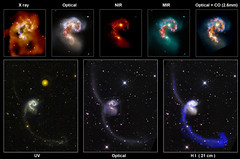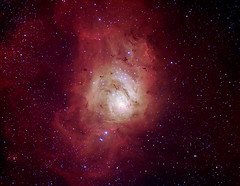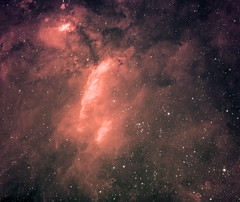The mass range of stars drawing their energy supply from nuclear fusion covers about three orders of magnitude. The least massive stars known have masses around 0.1 solar masses (M⊙) and the most massive examples are around 100 M⊙, although stars with masses of ~150M⊙ may also exist.
Massive stars are defined as those stars with masses higher than around 8 M⊙. However, this lower limit is not completely fixed, as the definition of massive star actually comes from those stars that ignite helium and afterwards carbon in non-degenerated stellar cores (i.e., the hydrostatic equilibrium is reached because the inward gravitational force is balanced with the outward force due to the pressure gradient of the gas). Depending on the evolutionary scenario, this happens between 7 and 9 M⊙.
Massive stars consume their fuel faster than low and intermediate mass stars: a solar-mass star has a life ~125 times longer than a 10 M⊙ star. Massive stars also are very luminous: a 100M⊙ star shines with a luminosity similar to ~1600 Suns. Hence, except for stars of transient brightness, like novae and supernovae, hot, massive stars are the most luminous stellar objects in the Universe.

Young, massive star clusters near the center of the Milky Way, at ~25,000 light-years from Earth: the Arches cluster (left) and the Quintuplet Cluster (right). Both pictures were taken using infrared filters by the NICMOS camera of the Hubble Space Telescope in September 1997. The galactic center stars are white, the red stars are enshrouded in dust or behind dust, and the blue stars are foreground stars between us and the Milky Way’s center. The clusters are hidden from direct view behind black dust clouds in the constellation Sagittarius. Credit: Don Figer (STScI) and NASA.
Massive stars are, however, extremely rare. Following the very famous results obtained by the Austrian-Australian-American astrophysicist Edwin Ernest Salpeter in 1955, the number of stars formed per unit mass interval is roughly proportional to M -2.35. Therefore we expect to find only very few massive stars in comparison with solar-type stars: for each 20M⊙ star in the Milky Way there are roughly a hundred thousand solar-type stars; for each 100M⊙ star there should be over a million solar-type stars.
However, despite their relative low number, massive stars have a fundamental influence over the interstellar medium and galactic evolution because they are the responsible of the ionization of the surrounding gas and they deposit mechanical energy first via strong stellar winds and later as supernovae, enriching the interstellar medium by returning unprocessed and nuclear processed material during their whole life. Massive stars therefore condition their environment and supply it with new material available for the birth of new generations of stars, being even the triggering mechanism of star formation. They also generate most of the ultraviolet ionization radiation in galaxies, and power the far-infrared luminosities through the heating of dust. The combined action of stellar winds and supernovae explosions in massive young stellar clusters leads to the formation of super-bubbles that may derive in galactic super-winds. Furthermore, massive stars are the progenitors of the most energetic phenomenon nowadays found, the gamma-ray bursts (GRBs), as they collapse as supernova explotions into black holes. Particularly, the interest in hot luminous stars has increased in the last decade because of the massive star formation at high redshift and the results of numerical simulations regarding the formation of the firts stars at zero metallicity (Population III stars), that are thought to be very massive stars with masses around 100M⊙.
The descents of the most massive, extremely hot (temperatures up to 200,000 K) and very luminous (105 to 106 solar luminosities, L⊙) O stars are Wolf-Rayet stars, which have typical masses of 25 – 30 M⊙ for solar metallicity.








Pingback: What are Wolf-Rayet stars? | The Lined Wolf